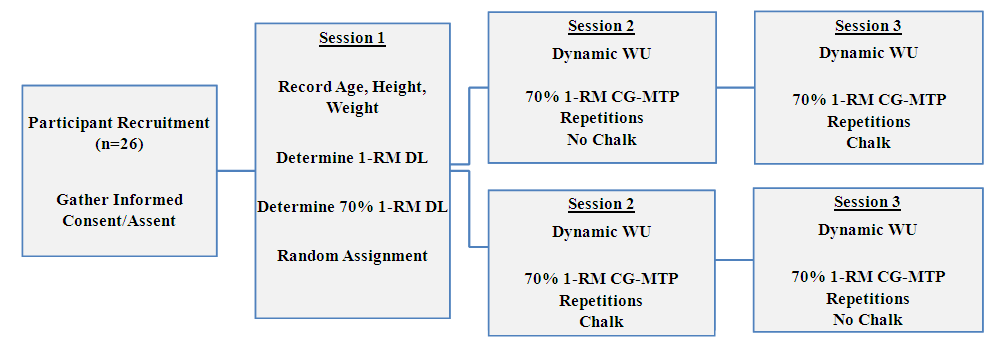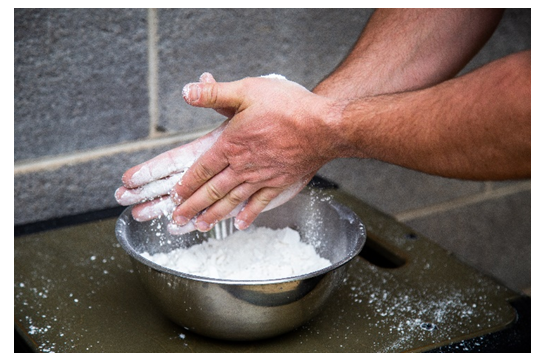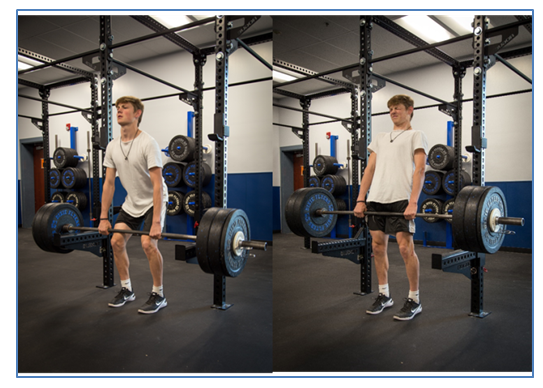-
Paper Information
- Paper Submission
-
Journal Information
- About This Journal
- Editorial Board
- Current Issue
- Archive
- Author Guidelines
- Contact Us
International Journal of Sports Science
p-ISSN: 2169-8759 e-ISSN: 2169-8791
2020; 10(2): 50-55
doi:10.5923/j.sports.20201002.04

The Effect of Grip Chalk on the Clean Grip Midthigh Pull
Jace McArthur, Paul Maggio, Mark DeBeliso
Southern Utah University, Department of Kinesiology and Outdoor Recreation, Cedar City, UT, USA
Correspondence to: Mark DeBeliso, Southern Utah University, Department of Kinesiology and Outdoor Recreation, Cedar City, UT, USA.
| Email: |  |
Copyright © 2020 The Author(s). Published by Scientific & Academic Publishing.
This work is licensed under the Creative Commons Attribution International License (CC BY).
http://creativecommons.org/licenses/by/4.0/

Magnesium Carbonate (MC) is often used by individuals to aid in the execution of the clean grip midthigh pulls (CG-MTP) as it aids in the hand coupling with the lifting bar. PURPOSE: This study analyzed the number of CG-MTPs performed at 70% of the subjects’ DL one repetition maximum (1-RM) both with MC and no magnesium carbon (NMC). METHODS: Male high school athletes participated in the study during three sessions separated by at least 48 hours (n=12, age=16.2±0.8 yrs, height=181.8±8.6 cms, mass=69.6±11.7 kgs). During the first session the participants recorded their age, height, weight, executed a dynamic warm-up (DW) and assessed their 1-RM DL. The second and third sessions employed a repeated measures cross over design. During the second session half of the participants performed a maximal repetition CG-MTP @ 70% 1-RM with NMC while the other half of the participants performed a maximal repetition CG-MTP @ 70% 1-RM with MC. During the third session the participants crossed over with regards to MC use. The CG-MTP maximal repetitions sets were executed with a closed overhand clean grip and a DW proceeded the CG-MTPs during both sessions 2 and 3. RESULTS: The number of repetitions performed with the use of MC (11.1±5.1) was significantly greater than the number of repetitions performed with the NMC (9.1±3.1) (p<0.05, effect size=0.6 SD, percent difference=22.5%). CONCLUSION: Within the parameters of this study, the use of MC did improve the number of CG-MTP repetitions performed. Coaches should implement the use of MC when their athletes are performing the CG-MTPs or derivatives of that lift.
Keywords: Deadlift, Magnesium carbonate, Coefficient of friction
Cite this paper: Jace McArthur, Paul Maggio, Mark DeBeliso, The Effect of Grip Chalk on the Clean Grip Midthigh Pull, International Journal of Sports Science, Vol. 10 No. 2, 2020, pp. 50-55. doi: 10.5923/j.sports.20201002.04.
Article Outline
1. Introduction
- Experts accept, and research demonstrates, that appropriate resistance training (RT) has a positive effect on athletic performance and injury prevention [1]. Athletes of all ages are in weight rooms with the goal of becoming stronger and developing the capacity to produce more effective sport specific capabilities. A multitude of variables play a role in this development, but one of the most important variables is the movements being performed. Power lifts (i.e. squat, bench press and deadlift) and Olympic lifts are comprised of movements that are effective for producing increased strength, power, and speed [2,3]. Power lifts include the back squat, deadlift, and bench press [2]. Despite the name given to these lifts, they are geared toward maximum strength. Strength is developed by moving heavy resistance at a relatively low velocity [1]. The bench press and squat are considered as measures of absolute strength for upper and lower body [4]. These lifts enable a person to move substantial amounts of weight in a safe and controlled pattern.The back squat and deadlift are total body exercises requiring more than the primary movers to be engaged. Core stability, posterior chain activation, and glute muscles are necessary to correctly perform either of these lifts [1,5]. The movement patterns specific to the back squat and deadlifts are considered to be specific to common movements in sport (i.e. athletic position, jumping, and running) but not to the degree as the Olympic lifts (or derivatives of) [3,6,7]. Olympic lifts such as the snatch and the clean and jerk are considered to be power training lifts [8]. Power training movements are executed with light to moderate loads with high velocities relative to the power lifts [1]. Power training increases muscular power, force output, and rate of force development [1]. The Olympic lifts (or derivatives of) are thought to be more sport specific when compared to the power lifts. This is primarily due to the association between executing the Olympic lifts at high velocities and the speed of movement in both contact and non-contact sports. Likewise, the Olympic lifts require triple extension which is also specific to sprinting, jumping and bounding [3,6,7].In contact sports such as American football and rugby, players need to be able to pick up and control opponents during competitive play. In noncontact sports such as volleyball, basketball, track and field, and other sports, athletes are required to move their own body mass horizontally and vertically in rapid bursts. The implementation of RT that focusses on power training via the Olympic lifts has been shown to increase athletic performance in a wide spectrum of athletic applications [3,9]. As such Olympic lifts, and derivatives of Olympic lifts have been included in many RT programs [3].Olympic lifting derivatives are variations of the Olympic lifts that eliminate the catch and overhead portions of Olympic lifts. Rather than performing the snatch and the clean and jerk, coaches are adapting the Olympic lifts to focus on different aspects of each movement [3,6,7]. Examples of Olympic lifting derivatives are the hang clean, jump shrug, clean grip and snatch midthigh pull, and the high pull [3]. When executing Olympic lifting derivatives, the loads are typically greater than with traditional clean and jerk as well as the snatch. Eliminating the catch portion of these lifts (and/or reducing the range of bar movement) dramatically reduces the difficulty of the lift, making it easier to load an increased amount of weight on the bar. The increased weight lifted elevates the RT induced stress on the neuromuscular and skeletal systems but may be limited by an athlete’s grip strength.Grip strength has been anecdotally observed as a limiting factor when executing Olympic pulling derivatives [10,11]. If the coupling of the hand to the bar is not sufficient to secure the bar in the hand during the lift, the lift will fail. It is common place to see athletes use chalk (magnesium carbonate-MC) in order to enhance the friction between the bar and the hand for the purpose of successfully securing the bar and improve the likelihood of completing the lift or set.Observationally MC has been used in a number of sport events such as: Olympic lifting, rock climbing, gymnastics, and throwing events [12]. However there is limited research that we are aware of examining the use of MC on athletic performance [13] and essentially non-existent specific to weightlifting [10]. Research by Bacon et al. [14] and Kilgas et al. [13] concluded that the use of MC enhanced pinch, openhanded grip, and a static hang to failure of climbing related tasks. While the results of the Bacon et al. [14] and Kilgas et al. [13] study were compelling in favor of MC’s ability to improve grip, it would not be reasonable to assume that the results apply to other tasks such as Olympic lifting derivatives. With that said, there appears a need to examine if the use of MC could facilitate performance of an Olympic lifting derivative.Hence the purpose of this study was to examine if the use of MC could improve grip ability for the purpose of enhancing the performance of the CG-MTP for maximal repetitions.We hypothesized that the more an athlete’s grip was secured, the more repetitions the athlete would be able to perform. The belief was that the use of MC would increase the coefficient of friction (CF) between the participant’s hand and the bar, resulting in a reduced amount of slippage [15]. Decreased slippage would enable the athlete to maintain a more secured grip, and thus decrease the use of energy and focus on grip in performing the desired repetitions [16,17]. Conversely, the absence of intervention would produce an increased amount of moisture to decrease the CF between the participant’s hands and the bar, causing the bar to slip in the hand, and triggering energy and focus being redirected from the performance of the lift to the grip, resulting in fewer continuous repetitions performed [18]. The significance of this study proposes to determine the effectiveness of using MC, a product that is a staple in gyms and competitions across the country. The finding of this study may lead to increased use, or elimination of gym chalk as an aid to lifting.
2. Methods
2.1. Participants
- Participants were a convenience sample of 12 male high school athletes. Participants had a minimum of 1-year prior exposure to RT in a weight room, and an additional 5 months of RT with 2-3 training sessions per week with a minimum of 3 hours and a maximum of 4.5 hours in the weight room per week supervised by the principal investigator of this study. Participants had passed a physical from a certified physician within the past year. The participants and their parents signed and an informed assent/consent form that was approved by the Institutional Review Board at Southern Utah University. Likewise, the study was approved by the SUU IRB committee prior to any interaction with the participants as related to the study.
 | Figure 1. Study timeline of events. 1-RM one repetition maximum. CG-MTP closed grip midthigh pull |
2.2. Instruments and Apparatus
- The study was conducted at one location: the Dixie High School weight room (St George, Utah). The weightlifting equipment included Olympic barbells, and Olympic bumper plates, a safety rack, a metronome, and MC (see figure 2). All of these items were property of Dixie High School.
 | Figure 2. Preparing hands with the chalk (magnesium carbonate-MC) |
2.3. Procedures and Assessment
- For approximately 5 months before the study was initiated, the participants engaged in a re-training on correct technique and posture to perform CG-MTP and performed them once a week at various loads and repetition ranges. Every time athletes performed the CG-MTP, they were under the observation of the strength and conditioning coach (principal investigator). Emphasis was put on starting position and grip. Participants were instructed to perform the CG-MTP with a closed overhand clean grip (see figure 3). This was done to decrease the level of potential variance introduced by the athletes using different types of grip styles and to be consistent with the grip style that the participants would employ when executing other RT modalities (i.e. power clean and front squat).
 | Figure 3. Illustration of the CG-MTP (clean grip midthigh pull) |
2.4. Statistical Analysis
- The independent variable in this study had two levels (conditions of MC and NMC). The dependent variable (DV) was the maximal number of repetitions performed of the CG-MTP @ 70% 1-RM. The DV was compared between the MC and NMC conditions with a Paired t-test (alpha<0.05). The effect size (Cohen’s ES) difference and percent difference (%Δ) of the DV between the two conditions were also calculated. Statistical calculations and data management were conducted with Microsoft Excel 2013. The assembled spread sheet of test data was peer reviewed for errors prior to analysis [22].
3. Results
- All twelve participants completed the study procedures without complication. The demographics of the participants are in Table 1. The number of repetitions performed with the use of MC (11.1±5.1) was significantly greater than the number of repetitions performed with NMC (9.1±3.1) condition (p<0.05) with an effect size difference of 0.6 standard deviations (SD).
|
|
4. Discussion
- The purpose of the study was to determine if the use of MC is an effective ergonomic aid to lifting, enabling a person to perform an increased number of repetitions at 70% 1-RM of the CG-MTP. It was hypothesized that the use of MC would allow an individual to have a more secure coupling with the bar by increasing the coefficient of friction between the hand and the lifting bar. The results of the current study suggest that the use of MC increased the maximal number of repetitions performed at 70% 1-RM of the CG-MTP. The maximal number of repetitions performed at 70% 1-RM of the CG-MTP was significantly greater with the use of MC was used on the hands to grip the bar (p=0.016). The difference in using MC equates to approximately 2 additional repetitions or a 22.5% average improvement with an effect size of 0.6 SDs. Nine of the twelve participants improved the number of repetitions with the use of MC (increase range 1-7 repetitions) with one additional participant completing the same number of receptions regardless of MC use. When the non-responders were removed from the analysis the impact of MC use was magnified. For those who responded positively to MC use the difference in using MC equated to approximately 3 additional repetitions or a 37% average improvement with an effect size of 0.9 SDs. In our opinion, the use of MC should provide the ability to chronically handle loads longer while performing the CG-MTP and likely other pulling movements, which in turn should lead to superior muscular adaptation over time.A primary goal of a strength and conditioning program is to create the best possible athlete with each individual that is in the program. Assigning the optimal load to a RT modality is imperative for the development of the athlete’s muscular strength and power attributes. However, the athletes ability to execute certain RT modalities at an optimal load maybe limited by grip strength or the inability to secure the bar effectively. An athlete’s inability to maintain an effective grip on the bar has the potential to limit the amount of weight an athlete can execute during an intense set or repetition. Athletes and coaches have used lifting straps to eliminate this factor [11,17,23], but by doing this they are not training the very weakness that needs to be addressed [10]. Coaches and athletes have used MC to aid grip in the RT environment, but there has been essentially no research on its effectiveness in the weight room setting [10]. Prior research has examined the COF between gloved hands and a cylindrical metal bar of 19.5 mm [12,24]. Carrie et al.’s [12] research findings suggested that the use of MC improved the ability of the gloved hand to grasp the bar. With that said, it should be noted that the Olympic lifting bar diameter ranges from 28-32 mm. Other research demonstrates MC as being effective with regards to improving performance of grip tasks associated with rock climbing [13,14,25]. However, the surfaces of an artificial and natural climbing setting are very different from a weight room and the gripping ability required when using an Olympic bar to execute a RT modality. There were several limitations regarding the current study. First, the athletes were high school athletes with prior RT experience but could certainly not be considered as being advanced in regards to RT experience. It is possible that as these athletes develop their 1-RM strength in the CG-MTP that their grip strength will become a greater limiting factor. As such, future research should include more advanced RT participants where the beneficial use of MC maybe become more pronounced.A second limitation also has to do with the participants being male. Men typically have greater grip strength then woman [26,27,28]. With that said, the use of MC may provide additional benefits to female athletes in order to facilitate the ability to grasp the bar during challenging sets or repetitions. As such, future research should include female participants where the favorable use of MC maybe become more prominent.A third limitation was in regards to familiarity with the assessment process. The assessment modality was similar to movements athletes have performed in prior RT sessions, but it was different in the sense that the assessment was executed to fatigue, to which they previously had minimal exposure. Likewise, the participants did not have prior experience completing CG-MTP to the cadence of a metronome beat. Future research might remove the metronome component of performing the assessment. Likewise, future research might utilize a higher percent of the 1-RM where grip failure is more likely to occur [16].When an athlete is performing lifts that require heavy loads, it is important to eliminate obstacles that would limit the effectiveness of executing the RT modality. Grip strength can be a limiting factor when executing the CG-MTP, and the primary movers of the modality are not the forearms. Because of this limitation, coaches may want to implement the use of MC to decrease the CF and increase the number of repetitions performed before the athlete needs to re-adjust grip or cut a set of repetitions short because of a loss of grip.
5. Conclusions
- The results of the current study suggested that the use of MC facilitated a meaningful increase in the maximal number of repetitions of the CG-MTP at 70% 1-RM. It is reasonable to think that chronically engaging in resistance training with heavier loads or increased repetitions of CG-MTPs (or derivatives of) will lead to superior muscular adaptations over time. We suggest that coaches should implement the use of MC when performing CG-MTPs or when executing RT modalities that implement the use of an Olympic bar that is loaded at a weight that may cause grip to be a limiting factor on performance.
 Abstract
Abstract Reference
Reference Full-Text PDF
Full-Text PDF Full-text HTML
Full-text HTML
